🌱 AP Environmental Science Unit 2 Notes
6-8% of The AP Test
Topics
2.1 Introduction to Biodiversity
2.2 Ecosystem Services
2.3 Island Biogeography
2.4 Ecological Tolerance
2.5 Natural Disruptions to Ecosystems
2.6 Adaptations
2.7 Ecological Succession
These notes are based on Mr Jordan Dischinger-Smedes’s YouTube videos and the fill in template notes for these videos created by Carolyn Kelleher Mendonca. Some changes were made. Videos available here.
Good luck on the AP Test! 🩷
2.1 Intro to Biodiversity
Diversity of life forms in an ecosystem; measured on 3 different levels:
Ecosystem Diversity: the number of diff. Habitats available in a given area
Species Diversity: the number of diff. Species in an ecosystem and the balance or evenness of the pop. sizes of all species in the ecosystem
Genetic Diversity: how different the genes are of individuals within a population (group of the same species)
Higher biodiversity = higher ecosystem / population health
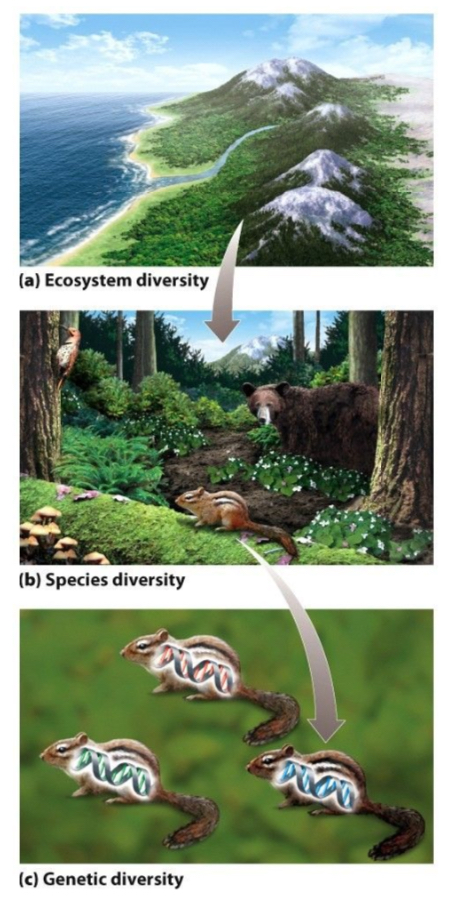
Richness (r) is just the total of different species found in an ecosystem. High (r) is generally a good sign of ecosystem health (more ore means more quality resources like H2O & soil)
Evenness is a measure of how all of the individual organisms in an ecosystem are balanced between the different species. Evenness indicates if there are one or two dominant species, or if population sizes are balanced
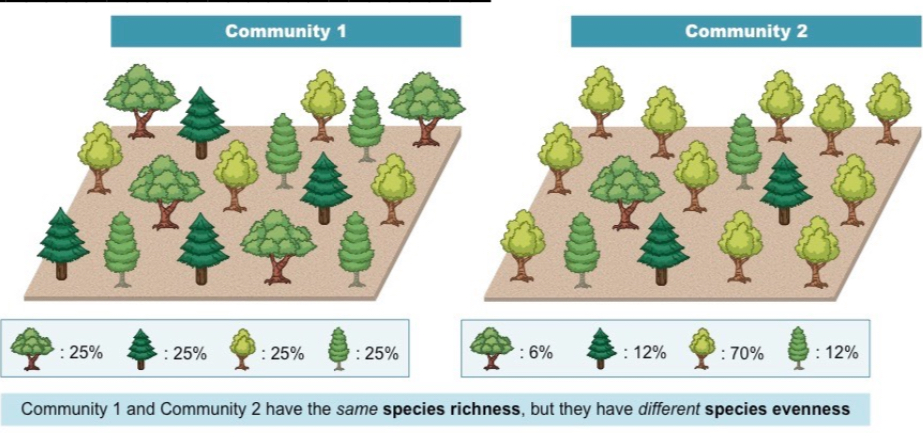
Genetic Diversity
Genetic Diversity = measure of how different the genomes (set of genes) are of the individuals within a population of a given species
There is genetic diversity in all populations because random copying of DNA & recombination of chromosomes in sex cells of parents leads to new gene combinations & new traits in offspring.
The more genetic diversity in a pop. the better the population can respond to env. Stressors like drought, disease, or famine
More genetic diversity - higher chance that some of the individuals in a pop. have traits that allow them to survive the environment.
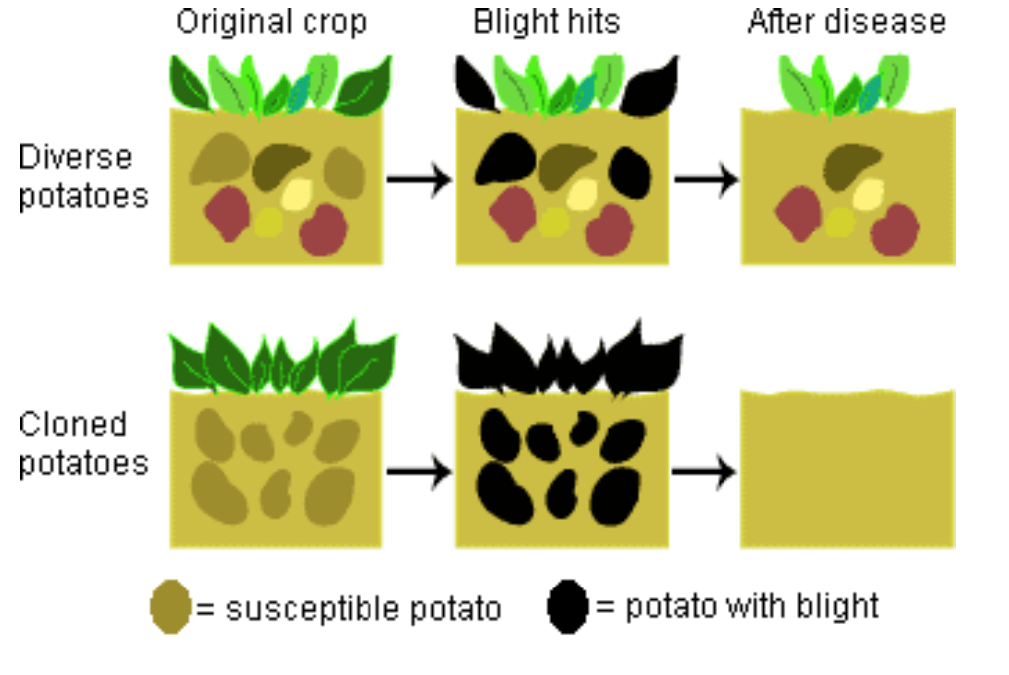
Bottleneck Event: An env. Disturbance (natural disaster/human hab. destruction) that drastically population size & kills organisms regardless of their genome
Surviving pop. is smaller and because individuals died randomly, it doesn’t represent the genetic diversity of the original pop
Bottleneck events reduce genetic diversity
Because the pop. is smaller & less genetically diverse, it’s even more vulnerable to future env. Disturbances.
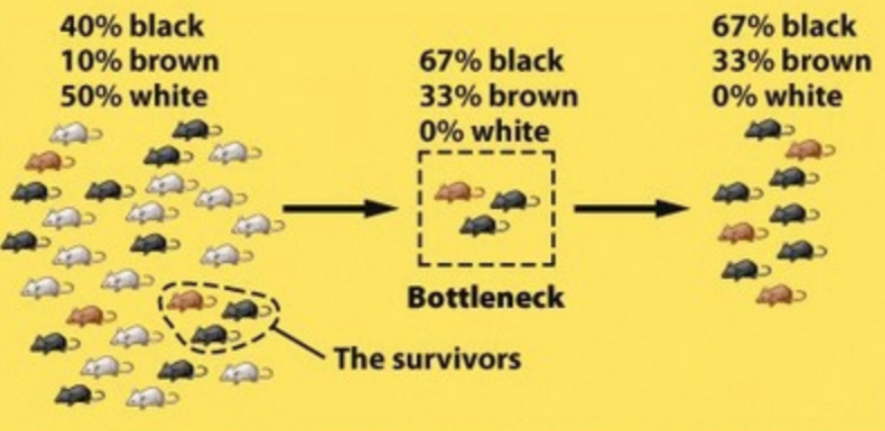
Inbreeding is when organisms mate with closely related “family” members
Leads to higher chances of offspring having harmful genetic mutations because they’re getting similar genotypes from both parents.
Smaller populations are more likely to experience inbreeding (difficult to find non-related mate)
Ex: Florida panther pop. Decreased down to 30 in the 1900s due to hunting & habitat loss. Inbreeding depression = kinked tails, heart defects, low sperm count, undescended testicles (saved in 95’ by pumas from Texas)
Resilience = the ability of an ecosystem to return to its original conditions after a major disturbance (wind storm, fire, flood, clear-cutting, etc.)
Higher species diversity = higher ecosystem resilience
High sp. div means more plant species to repopulate disturbed ground, anchor soil, and provide food & habitat for animal species
2.2 - Ecosystem Services
Goods that come from natural resources or services/functions that ecosystems carry out that have measurable economic / financial value to humans
Provisioning
Goods taken directly from ecosystems or made from nat. resources (wood, paper, food)
Regulating
Nat. ecosystems regulate climate / air quality, reducing storm damage & healthcare costs
Supporting
Nat. ecosystems support processings we do ourselves, making them cheaper & easier (bees pollinate crops)
Cultural
Money generated by recreation (parks, camping, tours) or scientific knowledge
Human activities disrupt the ability of ecosystems to function, which decreases the value of ecosystem services they provide
This has ecological (natural) and economic (money-based) consequences
Examples
Clearing land for ag./cities remove that store (more CO2 in atm. = more CC = more storm damage & crop failure)
Overfishing leads to fish population collapses (lost fishing jobs and lower fish sales in the future)
Provisioning Services
Goods/services directly provided to humans for sale by ecosystems
Ex: fish, hunting animals, lumber (wood for furniture/buildings) naturally grown foods like berries, seeds, wild grains, honey
Disturbed by overgrazing, overharvesting, water pollution, overfishing, land development.
Regulating Services
Benefit provided by ecosystem processes that moderate natural conditions like climate and air quality
Examples
Trees in a forest sequester (store) CO2 through photosynthesis which reduces rate of climate change & lessens damage caused by rising sea levels & reduces crop failure from drought
Trees filter air by absorbing air pollutants which reduces health care costs for treating diseases like asthma and bronchitis
Disrupted by deforestation.
Supporting Services
Natural ecosystems support processes we do ourselves, making them less costly and easier for us
Examples
Wetland plant roots filter pollutants, leading to cleaner groundwater that we don’t have to pay as much to clean with expensive water treatment plants
Bees & other insects pollinate our crops, leading to more production & higher products
Disrupted by pollinator habitat loss & filling in wetlands for development
Cultural Services
Revenue from recreational activities (hunting/fishing licenses, park fees, tourism-related spending) & profits from scientific discoveries made in ecosystems (health/ag./educational knowledge)
Examples
Beautiful landscapes draw tourists who pay to enter parks, spend money at local, or camping fees
Fishermen pay for fishing license to catch fish in clean rivers
Scientists learn about plant compounds that can lead to creation of new medicines which are used by humans
Disrupted by deforestation, pollution
2.3 - The Theory of Island Biodiversity
Study of ecological relationships & community structure on islands
Islands can be actual islands in a body of water or figurative habitat islands such as central park in New York City or National Parks (nat. habitats surrounded by human developed land)
Two basic “rules” or observations of Island Biogeography
Larger Islands support more total species
The larger the island, the greater the ecosystem diversity/richness
Greater ecosystem diversity = more food & habitat resources
More niches, or “roles” organisms can play in the ecosystem
Islands closer to the “mainland” support more species
Easier for colonizing organisms to get to island from mainland
More colonizing organisms = more genetic diversity in new pop.

Larger islands = Higher ecosystem diversity
More available “niches” or roles
Ex: all the different food sources available to birds on Galapagos
Larger pop. sizes (more genetically diverse and more resistant to env. Disturbance)
Lower extinction rate (species less likely to die off)
Positive correlation between island size & species richness
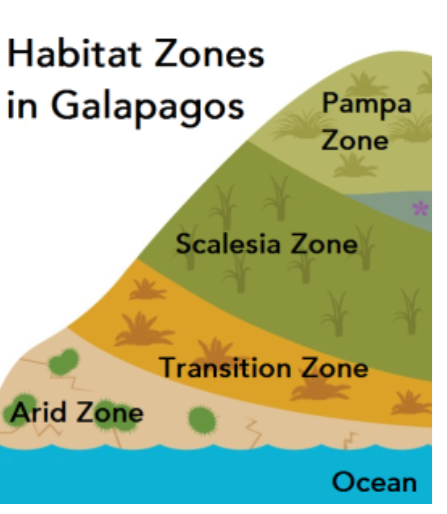
Closer to mainland = higher species richness
Easier for more species to migrate to island from mainland (swim/fly)
More continual migration of individuals to the island habitat
Frequent migration brings more genetic diversity & higher population size
Inverse relationship between island distance from mainland & species richness
The further away from mainland, the fewer species
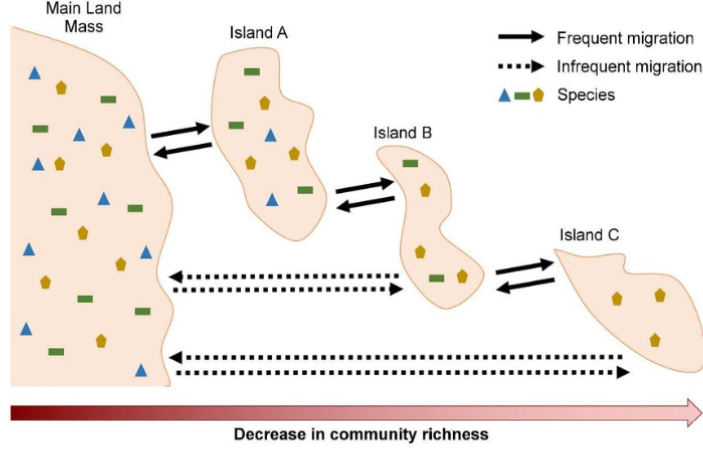
Different beaks quickly evolve to fit variety of different food sources on Island
Single colonizing species from the mainland quickly evolves to many slightly different species to adapt to new island cond.
2.4 Ecological Tolerance
Ecological Tolerance: Range of conditions such as temperature, salinity, pH, or sunlight that an organism can endure before injury or death results
Species and individual organisms both have a range of tolerance for all the different environmental conditions of their habitat
Ex: Salmon have a basic range of tolerance for temperature from 6* to 22* C. But some individual salmon have adaptations that give them a range of tolerance that is outside the basic range for the species.
Optimal Range: range where organisms survive, grow, and reproduce
Zone of Physiological Stress: range where organisms survive, but experience some stress such as infertility, lack of growth, decreased activity, etc.
Zone of Intolerance: range where the organism will die
Ex: Thermal shock, suffocation, lack of food/water/oxygen.
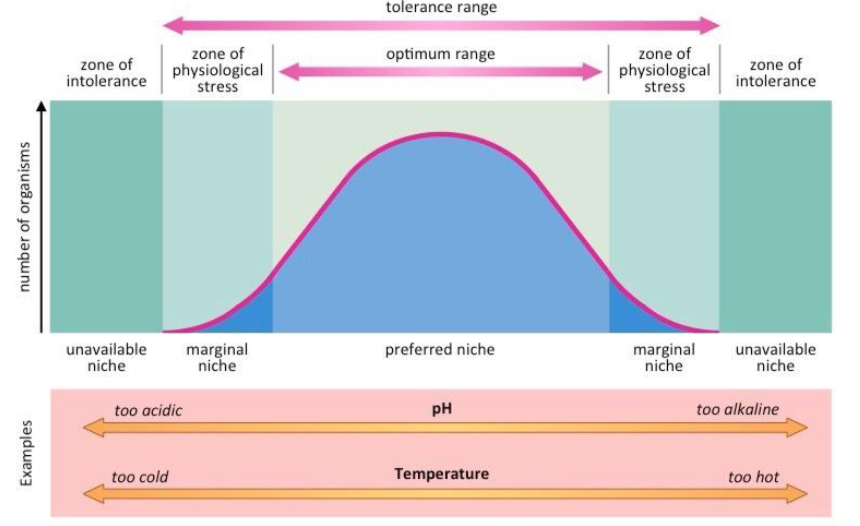
Safe Drinking Water Act
Required EPA to determine a maximum contaminant level; the maximum permissible amount of any pollutant that might adversely affect human health.
EPA establishes maximum contaminant levels (MCL) for 77 different elements or substances in both surface and groundwater
The UN estimated 5.6 million Americans drink water that does not meet EPA standards
1 in 5 Americans drink water from a treatment plant that has violated one or more safety requirements.
Water Quality Act
Authorizes states to come up with water quality standards aimed at controlling toxic pollutants discharges and nonpoint sources of pollutants.
Authorizes $18 Million for wastewater treatment
Addresses problems such as coastal estuaries, the Great Lakes, and the Chesapeake Bay
Aims to protect major areas with oxygen-depleting zones
2.5 Natural Disturbances to Ecosystems
A natural disturbance that disrupts the structure and or function of an ecosystem (Ex: tornadoes, hurricanes, asteroids, forest fires, drought) Natural disturbances can be even greater than human disruptions. These can occur on periodic, episodic, or random time frames.
Periodic: occurs with regular frequency
(ex: dry-wet seasons)
Episodic: occasional events with irregular frequency
(ex: droughts)
Random: no regular frequency
(ex: volcanoes, earthquakes, asteripods)
Earth’s climate has varied over geological time for numerous reasons (Ex: Slight changes in earth’s orbit & tilt cause mini ice ages & warmer periods) Sea level has varied over geological time as glacial ice on earth melts & forms.
Keeling Curve: After 1 year of data, Kelling discovered that CO2 levels varied seasonally and that CO2 levels increased from year to year. The work continues to this day, and confirms Keeling’s initial data.
Seasonal variation occurs due to +/- photosynthesis uptake in CO2
Yearly increase is correlated with increased human emissions from fossil fuels and net destruction of vegetation
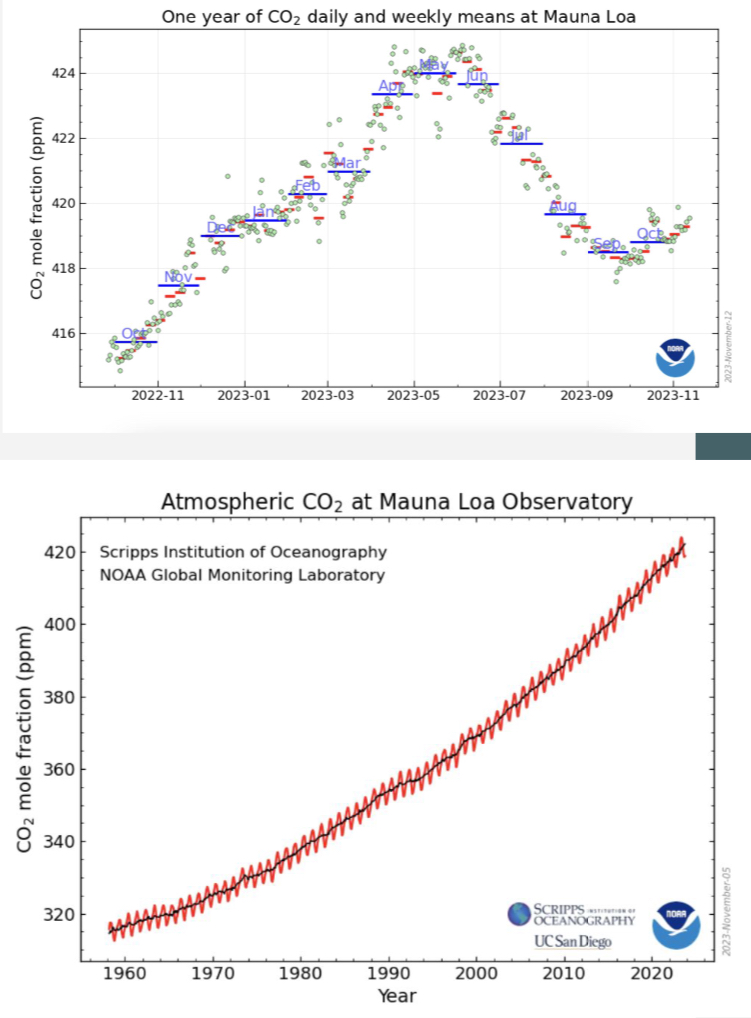
Major environmental disturbances result in widespread habitat chances and/or loss
Ex: Rising sea level floods coastal & estuary
Wildlife may migrate to a new habitat as the result of natural disturbances
Ex: wildebeests migrating to follow the rain patterns of African savanna
Ocean species moving further north as water temperature warms
Bird migration & breeding shifting earlier as insect hatching shifts earlier with warming climate
2.6 Adaptations
All populations have some genetic diversity, or variability in genomes of individuals; Genetic diversity exists because:
Random mutations while DNA is being copied create new traits
Crossing over in parent chromosomes creates new combinations of genes (and therefore traits)
Adaptation: a new trait that increases an organism’s fitness (ability to survive and reproduce)
Natural Selection: organisms that are better adapted to their env. survive and reproduce more offspring
Individuals with adaptations pass them on to offspring & individuals without adaptations die off, which leads to the entire population having the adaptation over time (evolution)
Selective pressure/force: the environmental condition that kills individuals without the adaptation
The environment an organism lives in determines which traits are adaptations.
As environments change, different traits may become adaptations & old traits may become disadvantages
Ex: a drought can kill off finches with smaller beaks, making larger beaks for cracking harder seeds an adaptation
The more rapidly an env. changes, the less likely a species in the env. will be to adapt to those changes
If the pace of env. change is too rapid, many species may migrate out of the env. or die off completely
Ex: if the ocean warms too quickly, many species of fish may not be able to migrate before they run out of oxygen and suffocate
The more genetic diversity in a population, the better they’re able to adapt to env.
Change (higher chance that some individuals have good mutations)
The longer the lifespan of the organism, the slower the rate of evolution
Ex: bacteria & virus can adapt and evolve in days
Human evolution = thousands-mil. years
2.7 Ecological Succession
Sucesion is a series of predictable stages of growth that a forest goes through.
Two types of succession:
Primary Succession: starts from bare rock in an area with no previous soil formation. Moss & lichen spores carried by the wind grow directly on rocks, breaking them down to form soil.
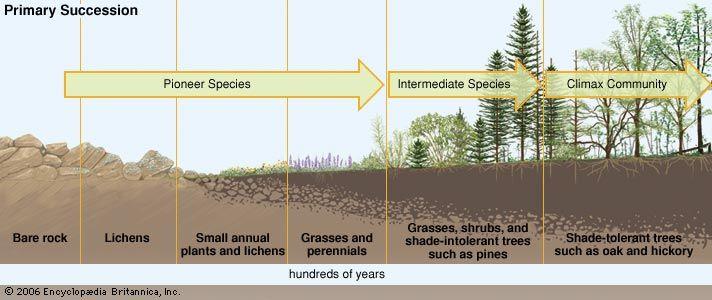
Secondary Succession: starts from already established soil, in an area where a disturbance (fire/tornado/human land clearing) cleared out the majority of plant life. Grasses, sedges, wildflowers, and berry bushes have seeds dispersed by wind or animal poop
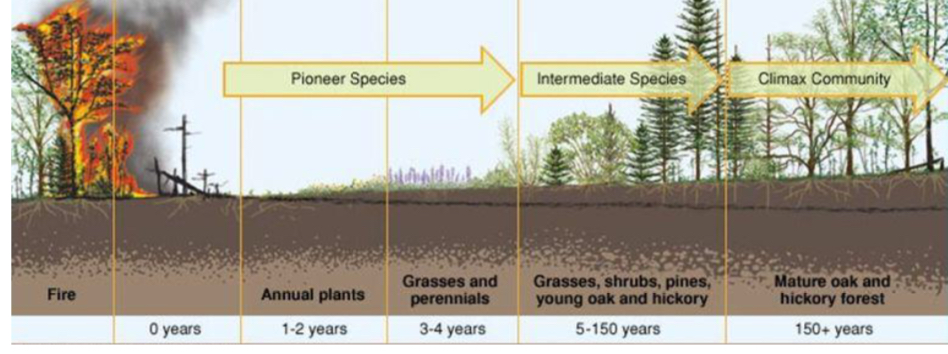
Pioneer species appear first, when the ground is simply bare rock, or bare soil after a disturbance. Characteristics: seeds spread by wind or animals, fast growing, tolerant of shallow soil and full sunlight Ex: moss, lichen (bare rock), wildflowers, raspberries, grasses/sedges
Mid-successional species appear after pioneer species have helped develop deeper soil with more nutrients by their cycles of growth/death. Characteristics: relatively fast growing , larger plants that need deeper soil with more nutrients than pioneers, sun tolerant. Ex: shrubs, bushes, fast-growing trees like aspen, cherry, and pine
Late successional or climax community species appear last, after soil is deepened and enriched with nutrients by cycles of growth and death by early & mid successional species. Characteristics: large, slow-growing trees that are tolerant of shade and require deep soils for large root networks. Ex: maples, oaks, other large trees
Primary
Occurs in an area that hasn’t previously been colonized by plants (bare rock)
Ex: volcanic rock, rock exposed after glacial retreat
Moss and Lichen (spores dispersed by wind) are able to grow directly on rock by
Secreting acids that break down rock & release mineral containing nutrients they need (N/P/K)
Chemical weathering of rocks by moss & lichen combined with organic matter from moss & lichen dying from some initial shallow soil
Secondary
Occurs in an area that already has established soil, but has had most plant life removed by a disturbance.
Pioneer species are still wind-dispersed seeds of plants that are fast-growing and sun-tolerant, but bushes/grasses/flowers instead of moss/lichen
Soil is already established & sometimes even enriched by nutrient-rich ash from fire; overall more rapid process than primary succession